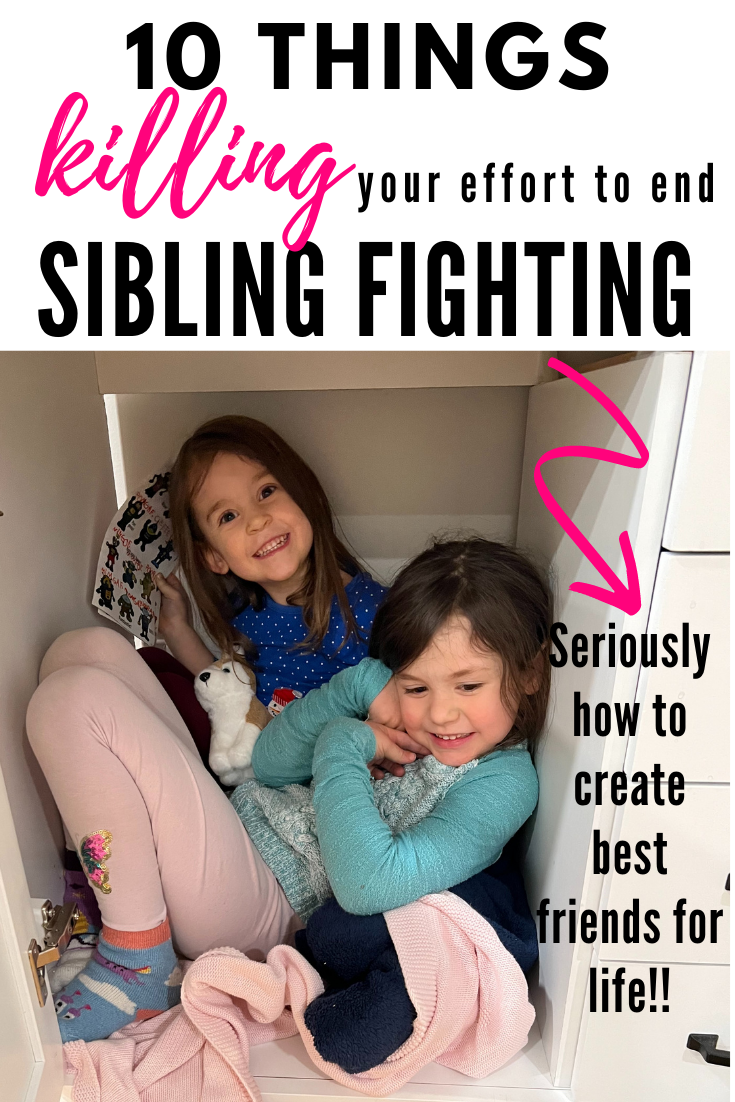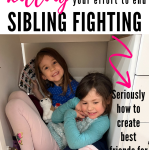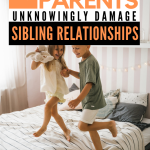I don’t think I am wrong when I say a lot of us have more than one kid in part because we want our kids to have siblings. Built in friends for life.
Preventing sibling rivalry was an important goal for me. I was never really close to any of my siblings, but it was something I really wanted for my kids. I envy my adult friends who are close to their siblings. They always have a close friend they can confide in or hang out with.
When I was pregnant with my second, I had all of these big aspirations to what I hoped my kids’ sibling relationship would look like. I wanted them to be best friends growing up and stay friends throughout their life. I pictured all of the laughter, the playing and the sibling love they would have for each other.
Since it was such a priority for me I felt pretty confident in preventing sibling rivalry. But, as you know with most things in parenthood, it was a lot harder than it ever looked. When the constant fighting and bickering started to develop along with a fierce rivalry, I felt so dejected.
To make a long story short, it took me a really long time and a lot of trial and error to learn how to foster a good sibling relationship. I also learned a lot about the role a parent can play in helping or hindering a sibling relationship. While of course my kids still fight, their relationship with each other has improved dramatically.
Therefore, it is my hope that by sharing what I learned, you can use these sibling bonding tips without having to go through the same mistakes I did to get there.
Never choose a side
This was my first mistake and one of my biggest mistakes. You can never choose a side in an argument, even when one kid is clearly in the wrong. I didn’t even realize I was taking sides when I would intervene in their arguments. It was actually mind-blowing when I realized it.
For instance, let’s take a classic example of sharing a toy. One child takes it from the other sibling. My usual response would be to say you have to give the toy back, you can’t take it if she is playing with it.
In my mind, I was helping my kid know what wasn’t right (can’t take a toy from someone) and helping them by telling them what they should do (give the toy back). However, by doing this I have essentially taken a side and gave them no opportunity to work it out.
Instead, you need both kids to hear each other out without giving your own opinion. For them to grow closer as siblings they need to make progress on working through their own arguments. Therefore, you need to moderate, not solve. Your goal here is to narrate observations. This is key for your kids to feel you are on their side. If they feel you always take one sibling’s side, then sibling rivalry starts.
Now, in the classic example of sharing a toy, I would first give them a few moments to see if they can figure it out. I always try to step in before it gets physical. If they aren’t able to figure it out, I usually come over and say something like “oh I see we both really want this bear huh.” This will usually get one kid to say something like “Yeah, it is MY bear and I had it first and she took it!” I will say something to sum up what was said and end with a question like “Okay, so you were playing with the bear and then you also wanted a turn? By doing this, I give my other kid a chance to state their point of view without accusing them of doing something wrong, which puts them on the defensive. My other kid will usually then say something like “I asked and waited for my turn, but she wouldn’t give me one!”
I would then sum up again such as “okay so you were playing with the bear first and then you took it because you were frustrated you didn’t get a turn but now you are upset because you weren’t done with your turn? We might go back and forth a few more times but the important part is to not give an opinion. I also might make statements like “so we have one bear and two kids… this is tricky” or “ah I see… yeah, I see why you both are so frustrated”
Your goal here is to get them talking to each other. Sum up what one says and give the other a chance to respond. Always bring it back to the actual issue (one bear, two kids) instead of focusing on the wrong doings (didn’t share, took toy, etc.). The wrong doings were their solutions because they weren’t able to talk it out. By narrating and moderating, you are teaching them how to talk it out.
If the fighting gets physical, I separate them first. I then always check on the one who is hurt first. Once both kids are calmer, I bring them back and we work our way through the argument.
Give them a chance to find a solution
Once they both have a chance to share their feelings and side of the story, state the issue again and ask them for solution ideas. For example, I could say “So it sounds like we both want to play with this bear, what are some solutions we could think of?” Depending on the argument, they might come up with some.
When a solution is brought up, again remain neutral. It doesn’t matter if you like the solution. What matters is the other kid likes the solution. If a solution is brought up and the other kid doesn’t like it, then I would say “oh okay then let’s keep thinking.”
If they don’t have any solutions, then I will suggest some solutions such as set a timer for turns. I might suggest a different game like play hide and seek and take turns hiding the bear so they are both playing with the bear. If the first child was playing pretend with the bear, then I might try to come up with a role the other kid could have in the play such as the babysitter to watch the bear when she goes to the grocery store.
Sometimes, I can tell we need to take a break first so I will suggest we do some coloring books or read a book together while the bear sits on the shelf. This will give them all time to cool down before revisiting the issue.
It might take us as a group 15 minutes to get to a solution and that’s okay. Conflict is hard and it takes time to build good resolution skills. Siblings will fight. It is inevitable. The best thing you can do is give them the tools to work it out independently. Siblings who learn how to work through their arguments with each other without a parent stand the best chance of being friends as adults.
Put them on the same team
Sometimes, if I can’t get them to agree on a solution, then I might do something like “oh I know, mom gets the bear and only superheroes will be able to save the bear from the monster.” I will then usually run away with the bear, and they will both come chasing after me. This method is usually effective because I have given them a common enemy (me) and they are now a team with the same goal.
In addition to using this strategy to end fights, I also try to pair them up as much as possible. When we play game nights, we will try to play kids vs parents as often as we can. You can use this for playing soccer or tag in the yard. You can also use this for jobs and chores. The more you pair them up, the more they can relate to each other.
No empty praise
I am very guilty of giving empty praise such as you are so smart! I have read time and again that you should refrain from these because they carry no weight and don’t build resilient kids.
I have no idea if that is true but I stopped using them for a different reason: sibling rivalry.
I found that if I said “you are so smart!” to one child, the other child hears “I’m not smart.” When they were little, the other would always say “look what I can do”, immediately after a compliment was given to a sibling. I also know from my own childhood, that is exactly how I felt.
I still complement my children I just always (try!) do it with example. I always put it in context of a situation. For example, “that picture has so much color! You must have worked really hard on that” instead of “your picture is so beautiful; you are such an amazing artist.” I could say to the second kid “and you drew a flying house, that is very creative. Who lives in that flying house?” This also gives me a chance to complement each kid’s picture without giving empty compliments.
I also try to always to praise my kids for their uniqueness and what they bring to the family. This avoids empty praises that can result in one feeling they aren’t as good as their sibling in your eyes.
For example, “wow that was a very silly dance, you bring so many smiles to our family. Look at your sister, she thinks you are hilarious!” instead of “you are so funny!” or “you make me so happy!” or “I love your silly dance.” Another way to help siblings bond is to encourage them to give each other compliments.
One on one time
I started prioritizing one on one time with my kids to improve my relationship with each of them. I read somewhere all of the benefits of “dating your kids” and it sounds like a wonderful idea.
While I think it does allow me to have closer relationships to my kids, the big success was actually they had so much less rivalry. They competed less for our attention.
I also had these big misconceptions that it had to be a big planned activity each time and that it needed to be a significant amount of time. When in reality, you only need about 30 minutes. Additionally, it doesn’t matter what you do, let them pick. Your child just wants your undivided attention once in a while. Honestly, sometimes my kid just wants me to listen to them talk while the other wants me to watch them draw.
Negative emotions are okay
I grew up in a house where it was important to love your sibling and always be nice. So I would say one of the biggest challenges for me as a parent was to see realize that my child could have negative emotions about their siblings and that was not only okay to voice, but also good for their sibling relationship.
When I took my second baby to her one of her newborn appointments, my preschooler came along. My pediatrician did something for me that I am still thankful for. She came in the room and chatted with my toddler about how frustrating it is to have a baby at home always taking mom and dad’s attention, always needing things, the loud crying. She taught me to see the perspective of my toddler.
In all relationships, you need a way to vent. Our toddler needed to know we understood that while she was happy to be a big sister, she was not happy about the changes. She needed us to validate those feelings and to know they were okay to have. After that, we saw a complete change in our toddler’s behavior towards baby.
A good sibling relationship isn’t one where they are always nice to each other and get along. A good sibling relationship is one where they are real with each other, they are allowed to voice their frustrations about each other, and they get into arguments, but they develop skills to solve them.
Teach them this magical rule to enter play
One problem we had with our kids was how one could join if play was already in progress. For example, my older is playing princess and her little sister wants to play. If she comes over and takes a crown so she can join the play, then my older one will see this as her taking the items that she was playing with (not her trying to play also).
At some point I read some kid psychology article that I wish I saved it to share with you, but it talked about this golden rule of entering play that has a crazy success rate. It not only has helped my kids play better together but also helped them socially with their friends.
First, don’t teach your child to ask them “can I play?” This gives kids a chance to say no. Instead, the best way to enter play in progress is to observe, complement and then help.
So, let’s go back to my older kid playing princess. The best way to join the play would be to first observe the play and see what is happening. That will allow the kid to compliment and offer help such as “I like your princess baby! I will go and find a blanket and pillow for the baby princess so she can sleep.”
With little kids, you have to model it until they can do it. For instance, I would go and sit and watch for a few moments and narrate the play such as “oh it looks like she has a baby and it’s a princess. This must be her princess castle. The baby is eating. Do you think the baby might need to sleep soon? Do you want to ask what the baby’s name is? Maybe you can get her a blanket and pillow. That can be your job, you can have a store that the princesses shop at?”
After enough practice, it becomes natural, and it really does work. It allows kids to give themselves roles in play instead of waiting for someone to invite them or give a job in the play.
Ensure time for them to develop their relationship
If you want them to have a friendship, then ensure you are giving them time to develop that friendship. They need one on one time with their sibling. As your kids get older, this can be really hard to do between having friends over and after school activities. But I challenge you to make it a priority.
To get this to work, you might need to plan activities for them to do that they both like such as sign up for a time to play tennis together at the gym. Maybe go to a paint class or buy a craft kit for them to do together. They will make memories as well as spend time working on their relationship. I have found that for this to really make the biggest difference, I do not join them. I set them up and then find something else to do. If I am there, then it is a different dynamic and not one on one time for them to bond.
Make Sibling Photo Books
Another way to help your siblings feel connected to each other is to find ways to remind them of this. Nothing helps me feel more connected to someone than seeing pictures that remind me of good memories.
One of the best ways I have found is to make photobooks focused on a sibling relationship. If you have two kids, then make one. If you have more, then you can make a book for each pair (ex: kid 1 with kid 2, kid 2 with kid 3 and kid 3 with kid 1) or you can make one big one that is a mix.
The difference between a sibling book and a family book is your goal. You want to have pictures that can remind the kids of all the fun they have with their sibling. Add in pictures of just the two (or three, etc) of them doing art together, sledding together, playing pretend, dress up, baking, hugging, going to the zoo.
I have made some using Mixbook or Shutterfly. I have also made some with my kids by printing out pictures and using glue.
Read Siblings Without Rivalry by Adele Faber and Elaine Mazlish
I know there are thousands of parenting books out there and honestly, I usually don’t recommend them often because I haven’t found them to be helpful. This is one of the exceptions. After reading Siblings Without Rivalry, I felt I had tools that I could actually apply. It was practical and had real life examples. It also did improve my kids’ relationships with each other.
The best part about these books is that they are made so you can read it lightning fast. In fact, each lesson always has a comic that shows you the lesson in action. You could honestly just read through all the comics and still be able to learn enough to apply it to your life.
They also have another book about how to listen to your kids that is also a great read, but I didn’t love it as much as I loved their siblings without rivalry book.
10 Ways to Prevent Sibling Rivalry
As with any relationship, it takes work to develop great sibling relationships. I hope by sharing what I have learned to help my kids get along with each other and grow closer will also help you.
Remember fighting between siblings is okay and use it as a way to teach them good conflict resolution skills so they eventually don’t need your help to get along.
Try to always stay non-judgmental and neutral. Be a referee or an observer. Offer solutions but give them time to express their feelings and give their side of things.
Pair them up as much as you can in games or activities as well as dedicating time each week for your kids to spend time bonding.
Lastly, make a sibling book that will remind them of all other awesome memories and times they had together to further strengthen that bond.
If you have a tip to create close knit siblings, then leave it in the comment section for our readers!
If you found this article on preventing sibling rivalry helpful, please share on Pinterest or Facebook


I am a wife, teacher, and mother to two awesome girls. I write about what I am passionate about, which includes being a mom, house projects, beauty and skincare. I love to share my experiences, failures, and successes with my readers. Let this space be a resource for you to pursue your very best day.




